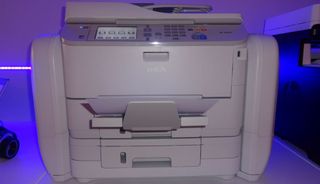Epson unveils 'game-changing' WorkForce Pro printer range with 75,000-page ink cartridges
Just under three pints per pouch

Epson announced a new business colour printer and MFP range yesterday in Vienna with a new headline technology called RIPS (Replaceable Ink Pack System).
It is a semi-permanent cartridge solution that allows the user to print up to 75,000 pages without replacing the ink and fills a gap in the market where businesses want to have a localised printer fleet with the predictability of a centralised model.
The four models, which will be exclusively available through select print service partners under managed print services (MPS) agreement, are the WorkForce Pro WF-5690DWF, the WF-5620DWF, the WF5190DW and the WF-5110DW; the last two are non-MFP models.
They all come with Epson's improved piezo-electric technology called PrecisionCore which, according to the company's spokespersons, doubles print quality while doubling (rather than halving) print speeds.
Quick scan
The default colour print speed is 30ppm (at 4800 x 1200 dpi) with mono being marginally higher at 34ppm (at 600 x 600 dpi). The MFPs also offer the ability to scan at 19 pages per minutes with a 35 pages duplex automatic document feeder plus they come with colour touchscreen displays.
All four have a maximum monthly duty cycle of 35,000 pages per month although Epson reckons that the bulk of business printers will churn between 1500 and 2500 pages per month. This means that any bundled ink could last up to four years, well beyond the average printer life expectancy.
Epson has yet to confirm when the RIPS-capable printers will go on sale. There will be no SRP given that the printers will only be available via MPS schemes.
Are you a pro? Subscribe to our newsletter
Sign up to the TechRadar Pro newsletter to get all the top news, opinion, features and guidance your business needs to succeed!

Désiré has been musing and writing about technology during a career spanning four decades. He dabbled in website builders and web hosting when DHTML and frames were in vogue and started narrating about the impact of technology on society just before the start of the Y2K hysteria at the turn of the last millennium.
